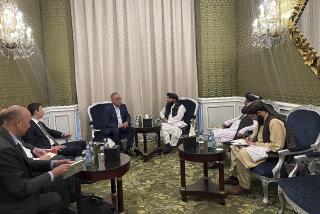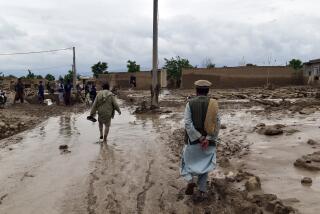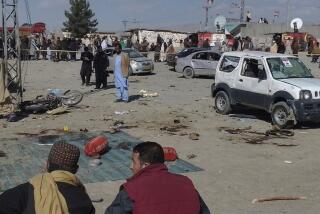Multiple bombings kill eight U.S. troops in Afghanistan
An early morning assault on a Kabul guest house by attackers armed with suicide vests and assault rifles killed six U.N. workers today, just a day after eight U.S. troops died in a pair of roadside bomb attacks in southern Afghanistan, making October the deadliest month of the eight-year war for American forces.
The campaign of violence foreshadowed an effort by the Taliban to disrupt a presidential runoff election that is less than two weeks away and came as a consensus is emerging within the Obama administration that more U.S. troops are needed in the country.
The deaths of the U.S. troops Tuesday brought the total number of U.S. service members killed during the month to at least 53, according to the independent website icasualties.org.
Army Gen. Stanley A. McChrystal, the top U.S. commander there, has reportedly requested 40,000 additional troops to pursue insurgents in Taliban strongholds, protect civilians and promote development to build support for the government.
Though the administration consensus includes agreement on continuing a counterinsurgency strategy, officials say the White House has not settled on a specific approach or the number of troops necessary to implement it.
U.S. officials have warned that an increase in insurgent attacks is likely before the Nov. 7 runoff election between President Hamid Karzai and former Foreign Minister Abdullah Abdullah.
“They are trying to influence the people of Afghanistan to prevent them from voting,” said Col. Wayne Shanks, spokesman for U.S. forces in the country.
Early today, three attackers with suicide vests and assault rifles attacked a United Nations guest house in an upscale neighborhood of Kabul, sparking a gun battle with Afghan security forces that lasted for more than an hour.
U.N. spokesman Adrian Edwards said six U.N. workers were killed in the assault and nine were wounded, some seriously. Their nationalities were not immediately known.
Gen. Abdul Ghafar Sayedzada, the Afghan Interior Ministry’s chief of criminal intelligence, said that in addition to the dead and wounded, seven U.N. workers were rescued from the house.
He said the attackers, who were not able to detonate their vests, all died -- as did two Afghan security officers and a civilian in a nearby house.
There was an increase in attacks leading up to the first round of voting two months ago; 45 U.S. troops were killed in July and 51 in August, previously the deadliest months for American forces.
The Aug. 20 election was marred by reports of widespread fraud. Annulled ballots cost Karzai nearly 1 million votes and left him just short of the 50% threshold for an outright win.
The Taliban claimed responsibility for Tuesday’s attacks.
“We don’t accept these two candidates,” Qari Yousef Ahmadi, a Taliban spokesman, said in a telephone interview. “This election is against Islam and against us.”
He said the attacks took place in Zabol province. Shanks did not identify the area pending notification of next of kin, but other military officials put the attacks in Kandahar province.
Seven of the Americans were killed in a single incident along with an Afghan civilian working with them, Shanks said. The roadside bombing targeted a U.S. armored vehicle patrol and was followed by a battle in which an unspecified number of insurgents were killed, he said.
The eighth American was killed in another roadside bombing, Shanks said.
Several wounded troops were evacuated for treatment after the attacks.
About 68,000 American troops are deployed in the country, along with 38,000 from 42 countries serving with the NATO-led International Security Assistance Force, or ISAF. Critics of a troop buildup have suggested a variety of more limited strategies that would focus on pursuing members of the Al Qaeda network without putting as many U.S. troops in harm’s way.
Sen. John F. Kerry (D-Mass.), chairman of the Senate Foreign Relations Committee, was one of the first influential Democrats to express reservations about a major troop buildup. However, Kerry signaled Monday that he agreed that the war should be fought as a counterinsurgency.
He said he would back a decision by President Obama to send “some additional troops,” provided improvements are made in Afghan troop training and governance and civilian aid efforts are increased.
“We simply don’t have enough troops or resources to launch a broad, nationwide counterinsurgency campaign. But more importantly, nor do we need to,” he said. “We all see the appeal of a limited counter-terrorism mission.”
One of the plans under consideration, first reported by The Times, would have U.S. forces focus on protecting people in Afghanistan’s top 10 population centers.
“The last couple of days have been a very tough couple of days for everybody involved,” Shanks said. But “I think you will see, as we work to make this a safer place, the attacks will come down here.”
Already, he said, U.S. forces are finding close to two-thirds of the roadside bombs -- commonly referred to as improvised explosive devices, or IEDs -- before the explosives detonate.
“As people come to trust us more, they will tell us about where these IEDs are hidden,” he said.
Improvised bombs in Afghanistan differ from those that have confronted U.S.-led troops in Iraq. At the height of the IED threat in Iraq, insurgents commonly relied on military explosives -- old artillery shells turned into roadside bombs.
In Afghanistan, there are far fewer caches of old munitions, so militants make homemade explosives. Those explosives are less effective, and insurgents compensate by producing bombs that are very large.
Because most of the IEDs are in rural areas, militants have time to excavate large holes without being discovered. Big holes can be detected by spy planes, and U.S. officials have assigned manned and unmanned flights to scan the roadways, military officials said.
Afghan insurgents have few radio-activated bombs, meaning that unlike in Iraq, American jammers are of little use in defending against many of the explosives. Instead, militants use long wires or pressure plates to trigger the explosions. The pressure plates often are made of wood to avoid their discovery by metal detectors.
The number of bombs has increased sharply this year, according to the Pentagon IED office. There were 2,548 attempted attacks in 2007, 3,783 in 2008 and 5,612 in the first nine months of this year. The Pentagon said 139 U.S. service members have been killed by IEDs in Afghanistan through September of this year. (The website icasualties.org says 105 have been killed by IEDs through Oct. 7.)
Military officials have said two helicopter crashes on Monday did not appear to have been insurgent-related.
Two choppers collided in midair in the south, and Shanks said there was no indication of hostile fire when a third one went down after a joint U.S.-Afghan anti-narcotics operation in the west. The crashes took the lives of 14 Americans: 11 troops and three law enforcement officials.
North Atlantic Treaty Organization forces on Tuesday recovered the remains of three American military contractors from the wreckage of a plane that crashed two weeks ago in the rugged mountains of northeastern Afghanistan.
--
alexandra .zavis@latimes.com
Times staff writer Julian E. Barnes in Washington and special correspondent Karim Sharifi in Kabul contributed to this report.
More to Read
Sign up for Essential California
The most important California stories and recommendations in your inbox every morning.
You may occasionally receive promotional content from the Los Angeles Times.










